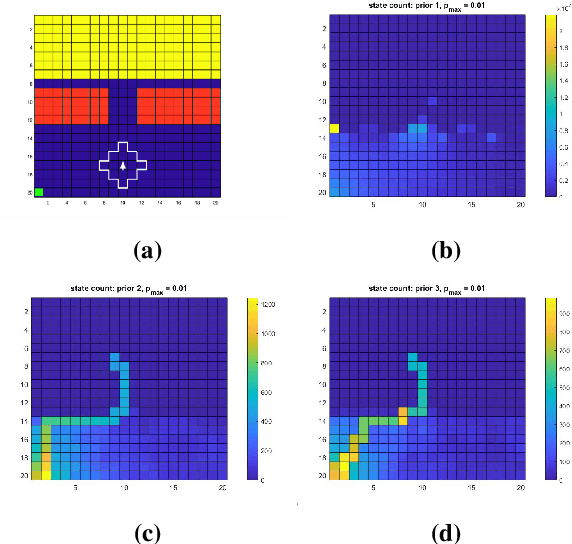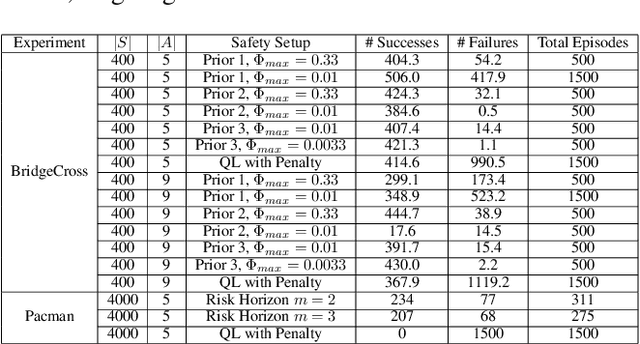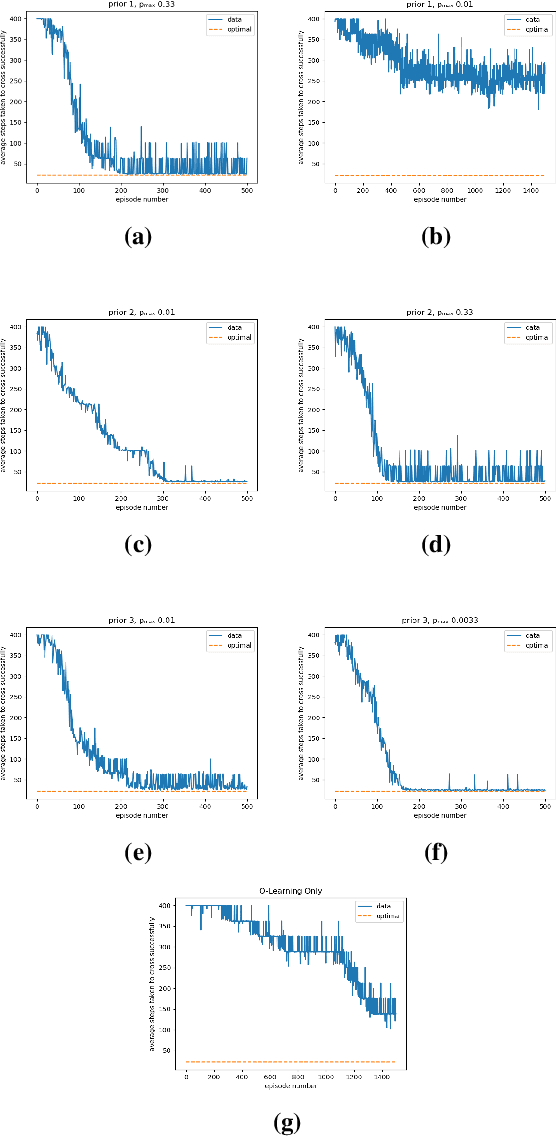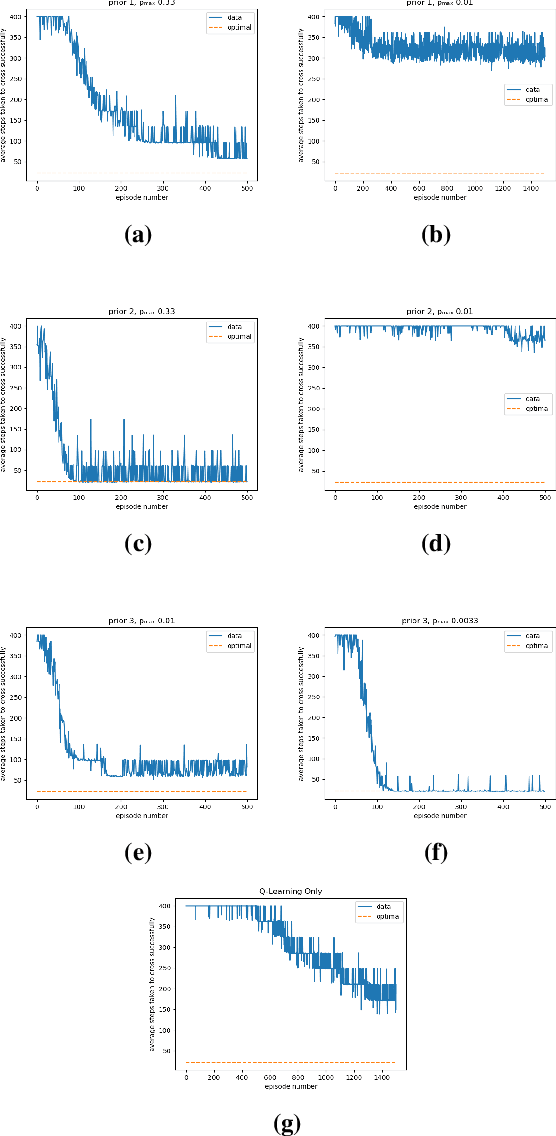Yiannis Kantaros
NAMO-LLM: Efficient Navigation Among Movable Obstacles with Large Language Model Guidance
May 07, 2025Abstract:Several planners have been proposed to compute robot paths that reach desired goal regions while avoiding obstacles. However, these methods fail when all pathways to the goal are blocked. In such cases, the robot must reason about how to reconfigure the environment to access task-relevant regions - a problem known as Navigation Among Movable Objects (NAMO). While various solutions to this problem have been developed, they often struggle to scale to highly cluttered environments. To address this, we propose NAMO-LLM, a sampling-based planner that searches over robot and obstacle configurations to compute feasible plans specifying which obstacles to move, where, and in what order. Its key novelty is a non-uniform sampling strategy guided by Large Language Models (LLMs) biasing the tree construction toward directions more likely to yield a solution. We show that NAMO-LLM is probabilistically complete and demonstrate through experiments that it efficiently scales to cluttered environments, outperforming related works in both runtime and plan quality.
HyperController: A Hyperparameter Controller for Fast and Stable Training of Reinforcement Learning Neural Networks
Apr 27, 2025Abstract:We introduce Hyperparameter Controller (HyperController), a computationally efficient algorithm for hyperparameter optimization during training of reinforcement learning neural networks. HyperController optimizes hyperparameters quickly while also maintaining improvement of the reinforcement learning neural network, resulting in faster training and deployment. It achieves this by modeling the hyperparameter optimization problem as an unknown Linear Gaussian Dynamical System, which is a system with a state that linearly changes. It then learns an efficient representation of the hyperparameter objective function using the Kalman filter, which is the optimal one-step predictor for a Linear Gaussian Dynamical System. To demonstrate the performance of HyperController, it is applied as a hyperparameter optimizer during training of reinforcement learning neural networks on a variety of OpenAI Gymnasium environments. In four out of the five Gymnasium environments, HyperController achieves highest median reward during evaluation compared to other algorithms. The results exhibit the potential of HyperController for efficient and stable training of reinforcement learning neural networks.
ConformalNL2LTL: Translating Natural Language Instructions into Temporal Logic Formulas with Conformal Correctness Guarantees
Apr 22, 2025Abstract:Linear Temporal Logic (LTL) has become a prevalent specification language for robotic tasks. To mitigate the significant manual effort and expertise required to define LTL-encoded tasks, several methods have been proposed for translating Natural Language (NL) instructions into LTL formulas, which, however, lack correctness guarantees. To address this, we introduce a new NL-to-LTL translation method, called ConformalNL2LTL, that can achieve user-defined translation success rates over unseen NL commands. Our method constructs LTL formulas iteratively by addressing a sequence of open-vocabulary Question-Answering (QA) problems with LLMs. To enable uncertainty-aware translation, we leverage conformal prediction (CP), a distribution-free uncertainty quantification tool for black-box models. CP enables our method to assess the uncertainty in LLM-generated answers, allowing it to proceed with translation when sufficiently confident and request help otherwise. We provide both theoretical and empirical results demonstrating that ConformalNL2LTL achieves user-specified translation accuracy while minimizing help rates.
Safety Monitoring for Learning-Enabled Cyber-Physical Systems in Out-of-Distribution Scenarios
Apr 18, 2025Abstract:The safety of learning-enabled cyber-physical systems is compromised by the well-known vulnerabilities of deep neural networks to out-of-distribution (OOD) inputs. Existing literature has sought to monitor the safety of such systems by detecting OOD data. However, such approaches have limited utility, as the presence of an OOD input does not necessarily imply the violation of a desired safety property. We instead propose to directly monitor safety in a manner that is itself robust to OOD data. To this end, we predict violations of signal temporal logic safety specifications based on predicted future trajectories. Our safety monitor additionally uses a novel combination of adaptive conformal prediction and incremental learning. The former obtains probabilistic prediction guarantees even on OOD data, and the latter prevents overly conservative predictions. We evaluate the efficacy of the proposed approach in two case studies on safety monitoring: 1) predicting collisions of an F1Tenth car with static obstacles, and 2) predicting collisions of a race car with multiple dynamic obstacles. We find that adaptive conformal prediction obtains theoretical guarantees where other uncertainty quantification methods fail to do so. Additionally, combining adaptive conformal prediction and incremental learning for safety monitoring achieves high recall and timeliness while reducing loss in precision. We achieve these results even in OOD settings and outperform alternative methods.
Minimum-Violation Temporal Logic Planning for Heterogeneous Robots under Robot Skill Failures
Oct 22, 2024Abstract:In this paper, we consider teams of robots with heterogeneous skills (e.g., sensing and manipulation) tasked with collaborative missions described by Linear Temporal Logic (LTL) formulas. These LTL-encoded tasks require robots to apply their skills to specific regions and objects in a temporal and logical order. While existing temporal logic planning algorithms can synthesize correct-by-construction paths, they typically lack reactivity to unexpected failures of robot skills, which can compromise mission performance. This paper addresses this challenge by proposing a reactive LTL planning algorithm that adapts to unexpected failures during deployment. Specifically, the proposed algorithm reassigns sub-tasks to robots based on their functioning skills and locally revises team plans to accommodate these new assignments and ensure mission completion. The main novelty of the proposed algorithm is its ability to handle cases where mission completion becomes impossible due to limited functioning robots. Instead of reporting mission failure, the algorithm strategically prioritizes the most crucial sub-tasks and locally revises the team's plans, as per user-specified priorities, to minimize mission violations. We provide theoretical conditions under which the proposed framework computes the minimum violation task reassignments and team plans. We provide numerical and hardware experiments to demonstrate the efficiency of the proposed method.
Safe Task Planning for Language-Instructed Multi-Robot Systems using Conformal Prediction
Feb 23, 2024



Abstract:This paper addresses task planning problems for language-instructed robot teams. Tasks are expressed in natural language (NL), requiring the robots to apply their capabilities (e.g., mobility, manipulation, and sensing) at various locations and semantic objects. Several recent works have addressed similar planning problems by leveraging pre-trained Large Language Models (LLMs) to design effective multi-robot plans. However, these approaches lack mission performance and safety guarantees. To address this challenge, we introduce a new decentralized LLM-based planner that is capable of achieving high mission success rates. This is accomplished by leveraging conformal prediction (CP), a distribution-free uncertainty quantification tool in black-box models. CP allows the proposed multi-robot planner to reason about its inherent uncertainty in a decentralized fashion, enabling robots to make individual decisions when they are sufficiently certain and seek help otherwise. We show, both theoretically and empirically, that the proposed planner can achieve user-specified task success rates while minimizing the overall number of help requests. We demonstrate the performance of our approach on multi-robot home service applications. We also show through comparative experiments, that our method outperforms recent centralized and decentralized multi-robot LLM-based planners in terms of in terms of its ability to design correct plans. The advantage of our algorithm over baselines becomes more pronounced with increasing mission complexity and robot team size.
Safeguarded Progress in Reinforcement Learning: Safe Bayesian Exploration for Control Policy Synthesis
Dec 18, 2023



Abstract:This paper addresses the problem of maintaining safety during training in Reinforcement Learning (RL), such that the safety constraint violations are bounded at any point during learning. In a variety of RL applications the safety of the agent is particularly important, e.g. autonomous platforms or robots that work in proximity of humans. As enforcing safety during training might severely limit the agent's exploration, we propose here a new architecture that handles the trade-off between efficient progress and safety during exploration. As the exploration progresses, we update via Bayesian inference Dirichlet-Categorical models of the transition probabilities of the Markov decision process that describes the environment dynamics. This paper proposes a way to approximate moments of belief about the risk associated to the action selection policy. We construct those approximations, and prove the convergence results. We propose a novel method for leveraging the expectation approximations to derive an approximate bound on the confidence that the risk is below a certain level. This approach can be easily interleaved with RL and we present experimental results to showcase the performance of the overall architecture.
Mission-driven Exploration for Accelerated Deep Reinforcement Learning with Temporal Logic Task Specifications
Nov 28, 2023


Abstract:This paper addresses the problem of designing optimal control policies for mobile robots with mission and safety requirements specified using Linear Temporal Logic (LTL). We consider robots with unknown stochastic dynamics operating in environments with unknown geometric structure. The robots are equipped with sensors allowing them to detect obstacles. Our goal is to synthesize a control policy that maximizes the probability of satisfying an LTL-encoded task in the presence of motion and environmental uncertainty. Several deep reinforcement learning (DRL) algorithms have been proposed recently to address similar problems. A common limitation in related works is that of slow learning performance. In order to address this issue, we propose a novel DRL algorithm, which has the capability to learn control policies at a notably faster rate compared to similar methods. Its sample efficiency is due to a mission-driven exploration strategy that prioritizes exploration towards directions that may contribute to mission accomplishment. Identifying these directions relies on an automaton representation of the LTL task as well as a learned neural network that (partially) models the unknown system dynamics. We provide comparative experiments demonstrating the efficiency of our algorithm on robot navigation tasks in unknown environments.
Verified Compositional Neuro-Symbolic Control for Stochastic Systems with Temporal Logic Tasks
Nov 22, 2023Abstract:Several methods have been proposed recently to learn neural network (NN) controllers for autonomous agents, with unknown and stochastic dynamics, tasked with complex missions captured by Linear Temporal Logic (LTL). Due to the sample-inefficiency of the majority of these works, compositional learning methods have been proposed decomposing the LTL specification into smaller sub-tasks. Then, separate controllers are learned and composed to satisfy the original task. A key challenge within these approaches is that they often lack safety guarantees or the provided guarantees are impractical. This paper aims to address this challenge. Particularly, we consider autonomous systems with unknown and stochastic dynamics and LTL-encoded tasks. We assume that the system is equipped with a finite set of base skills modeled by trained NN feedback controllers. Our goal is to check if there exists a temporal composition of the trained NN controllers - and if so, to compute it - that will yield a composite system behavior that satisfies the assigned LTL task with probability one. We propose a new approach that relies on a novel integration of automata theory and data-driven reachability analysis tools for NN-controlled stochastic systems. The resulting neuro-symbolic controller allows the agent to generate safe behaviors for unseen complex temporal logic tasks in a zero-shot fashion by leveraging its base skills. We show correctness of the proposed method and we provide conditions under which it is complete. To the best of our knowledge, this is the first work that designs verified temporal compositions of NN controllers for unknown and stochastic systems. Finally, we provide extensive numerical simulations and hardware experiments on robot navigation tasks to demonstrate the proposed method.
Uncertainty-bounded Active Monitoring of Unknown Dynamic Targets in Road-networks with Minimum Fleet
Sep 19, 2023



Abstract:Fleets of unmanned robots can be beneficial for the long-term monitoring of large areas, e.g., to monitor wild flocks, detect intruders, search and rescue. Monitoring numerous dynamic targets in a collaborative and efficient way is a challenging problem that requires online coordination and information fusion. The majority of existing works either assume a passive all-to-all observation model to minimize the summed uncertainties over all targets by all robots, or optimize over the jointed discrete actions while neglecting the dynamic constraints of the robots and unknown behaviors of the targets. This work proposes an online task and motion coordination algorithm that ensures an explicitly-bounded estimation uncertainty for the target states, while minimizing the average number of active robots. The robots have a limited-range perception to actively track a limited number of targets simultaneously, of which their future control decisions are all unknown. It includes: (i) the assignment of monitoring tasks, modeled as a flexible size multiple vehicle routing problem with time windows (m-MVRPTW), given the predicted target trajectories with uncertainty measure in the road-networks; (ii) the nonlinear model predictive control (NMPC) for optimizing the robot trajectories under uncertainty and safety constraints. It is shown that the robots can switch between active and inactive roles dynamically online as required by the unknown monitoring task. The proposed methods are validated via large-scale simulations of up to $100$ robots and targets.
 Add to Chrome
Add to Chrome Add to Firefox
Add to Firefox Add to Edge
Add to Edge